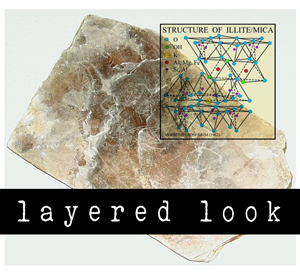

Chrysocholla takes its name from the Greek chryos, meaning "gold", and kolla, meaning "glue". At the time, it was used as a product to solder gold. It is frequently grown with other materials like turquoise, quartz, malachite and opal to form a harder mineral. It is usually blue or blue-green. Because it is a softer stone, it is often stabilized like turquoise to improve durability.
Clay-based jewelry components are rarely the clay minerals themselves because they are too soft to be much use. However, clay minerals like kaolinite are vital for the creation of pottery and porcelain. Kaolinite is the principal component of china clay, used in the manufacture of famous Chinese porcelain. Porcelain can be made of other clay minerals, but kaolinite remains a common ingredient. Clay minerals like kaolinite are a group of sheet silicate minerals that crystallize in a monoclinic structure. They form from the weathering of feldspars and other aluminum rich minerals into deposits of sedimentary rocks.
Lepidolite is from the Greek lepidos for "scale" and lithos for "stone". It is the Earth's most common lithium bearing mineral. It is pink to pale lilac in color and sometimes yellow. It contains rubidium, which can be used to date rocks more than 10 million years ago. (Naturally occurring rubidium contains a beta-emitting isotope with a half life of 49 billion years.) It occurs in granite pegmatites, along with other lithium minerals: beryls, topaz, quartz, tourmaline and kunzite.
Mica has perfect cleavage, as any kid playing with the stone understands. With a fingernail or knife, it's possible to separate pale flexible sheets, almost like magic. The mica stones used here have been coated for durability to enjoy the golden sheen for years to come.
Seraphinite takes its name from seraphim, a class of biblical angels, because of the unusual feather pattern of the silvery inclusions within the deep green gemstone. The feathery inclusions are formed from mica that aligns in complex structures within the stone. Seraphinite is a silicate mineral called a clinochlore, part of the chlorite group.
Unlike chalk, which is primarily calcite, talc is a magnesium hydroxide silicate. Soapstone is a form of compact talc with a slightly soapy or greasy feel that has been used across the centuries for carving figurines and receptacles. It is a soft stone so it is not often used in jewelry. Soapstone beads are typically coated to improve appearance and durability.
Fuchsite is a green variety of mica, and ruby in fuchsite refers to the presence of conrundum within the fuchsite. Unlike ruby zoisite, ruby fuchsite shows blue kyanite surrounding the ruby and lacks the scattered black hornblende crystals. Ruby fuchsite is also much softer than ruby zoisite, owing to the fact that fuchsite is a mica and therefore soft.
Like chrysocholla, shattuckite forms in copper rich regions. It's a copper silicate hydroxide mineral (SiO3) rather than a copper carbonate mineral like azurite, but it shares the same deep blue to blue green coloration as azurite and chrysocholla. It takes its name from its source; shattuckite was first discovered in the Shattuck copper mine near Bisbee, Arizona in 1915.